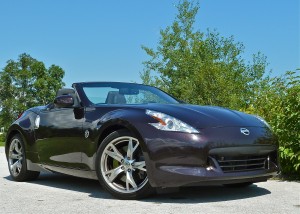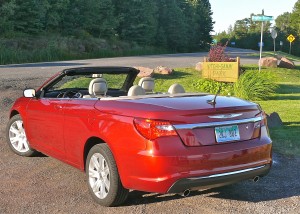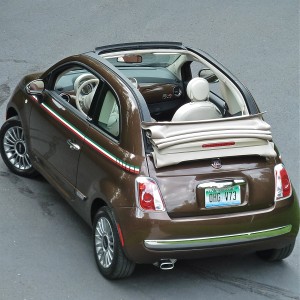Budget convertibles meet top-down demands

The Mazda MX-5 Miata brings the pleasure of traditional British roadsters to contemporary trouble-free motoring.
By John Gilbert
Ah, Indian Summer. Or does our recent political correctness require us to call it “Native American Summer?†In any case, it’s that wonderful stretch of autumn that comes after September, when the temperatures make one more summer-like climb after the leaves already have changed color and started falling in wind-blown disarray.
Those of us who live where it snows in earnest can enjoy Indian Summer more than those from more temperate climes, and one of the greatest features of the annual late warm-up is the reappearance of convertibles. Yes, we thought we’d seen the last of drop-top, open-air vehicles when the first chill followed traditional summer, but right here in Minnesota, record temperatures in the 80s and even 90s visited in mid-October, and top-down driving made its usual reappearance.
When my mind wanders to the perfect scenario of a convertible, it is of a top-down roadster approaching around a gentle curve, sweeping past, and disappearing, leaving only a flurry of fallen leaves fluttering in its wake.
An earlier column gave an overview of various luxury convertibles, including the Jaguar XK, the BMW 6-Series, the Corvette, and the Mustang-challenging Camaros. But there are more, many more, taking advantage of the current trend toward specialty cars, and not all of them cost from $40,000 to $120,000. There are some convertibles-on-a-budget that meet all the requirements of open-air enjoyment, while also delivering impressive fuel economy, and starting at a price that any new-car budget could manage.
To start with, we have a couple of traditional icons, in the Mazda Miata MX-5, and the Nissan Z-Roadster. Add in the new Chrysler 200 Convertible, which is a bold exponent of what used to be the Sebring Convertible — a four-seat vehicle that didn’t sell as well as Chrysler would have hoped, but made up for it as the No. 1 rental convertible offered anywhere, because of its four seats. While Fiat now owns Chrysler and Dodge, and has had a major impact on the Chrysler 200 inside and out, we can’t overlook the new Fiat 500 Cabrio, which is only cheating a little on the convertible theme with a flexible sunroof that slides all the way back and down to meet the requirement for open-air driving.
-
Mazda MX-5 Miata. We are giving in to Mazda’s curious insistence that all its cars have alpha-numeric designation, which means giving up the worldwide recognition the name Miata generates, but at least now Mazda adds the iconic Miata name to MX-5. Always popular as a 2-seat roadster that recalls the great British sports cars of the 1950s in style, but without the need for getting to know your serviceman on a first-name basis, the newest Miata is an uncompromising thrill to drive. It has a 2.0-liter 4-cylinder engine — the engine Mazda once shared with Ford, which still is Ford’s base engine for everything including the new EcoBoost — with 167 horsepower and 140 foot-pounds of torque. A 6-speed manual transmission brings it all to life, and the willing-to-rev aluminum engine drives the rear wheels with traditional sports-car dash. The car stays flat no matter how tight the curve, and refinements such as limited-slip, front and rear stabilizer bars, a brace between shock towers, and an aluminum powertrain frame make the new Miata the best one yet, and if you ease off and focus on mellow driving, you can top the EPA estimated 28 miles per gallon and reach 30. But driving a Miata mellow is difficult to imagine. I recall driving an early Miata, a couple of decades ago, and my now-adult son, Jack, was riding with me. Stubbornly, I left the top down as some black clouds moved in, and when it started raining, we were in heavy traffic. I slowed down a bit, reached back with my right arm and found that without even a glance, my fingertips perfectly fit into the top’s hand-grip, so I yanked it forward. The folded top popped up, I secured it with the turn of a handle, while Jack, and probably the driver behind us, had to be impressed with the brief show. You could still do that with the new Miata, but the test car was the Special Edition, and came with the optional retractable hardtop. It disappears under a panel above the trunk, and goes up and down swiftly at the touch of a button. The Miata Special Edition costs $32,000, but normal Miatas start lower, and are just as much fun to drive.
- Nissan Z Roadster. The test car is a show of how far Nissan has come since it first made the 240-Z three decades ago. The original was a bargain sports car, while the new model, which was the loaded Touring model, is crammed from its tires to its soft top with goodies and gadgets that boost it up to compete with much costlier sports cars, but also boost the price from a base just over
$40,000 to $47,370. The performance of the Z is closer to exotic cars than lightweight roadsters, courtesy of Nissan’s newly enlarged 3.7-liter V6, which has 332 horsepower and 270 foot-pounds of torque. The engine used to be 3.5 liters, so the sports car was called the 350Z, but apparently Nissan didn’t like the sound of “370Z,†so the new car is simply the Z Roadster. The new engine has a microfinished crankshaft and camshafts, continuously variable valve timing, independent aluminum double-wishbone suspension up front and multi-link rear, with front and rear stabilizer bars. That means that more power is accompanied by better fuel economy (EPA 25 mpg highway). The Touring version has a Sport package with SynchroRev Match on the stick shift, a device that electronically causes the revs to blip whenever you downshift. Nissan knows that knowledgable drivers tap the throttle whenever they downshift, but with this model, it’s unnecessary because it’s done for you, precisely and automatically. The package also includes viscous limited slip, 19-inch forged wheels instead of stock 18s, sport brakes with Nismo performance brake pads that are a stand-alone $580 option. The navigation system has a hard-drive base with 7-inch monitor, USB connection interface, streaming audio via Bluetooth, DVD video playback capability, and XM satellite with NavWeather. Heated and cooled power leather seats are standard, as are the 8-speaker Bose audio, keyless entry and ignition, and bi-function Xenon lights. It would be interesting to drive a Z Roadster stripped of all those very-impressive features and options, and certainly the price would be cut by one-third. But as it sits, the black-cherry Z Roadster lurks looking black until the sunlight hits it. And by then, the power-folding, automatic-latching top would be down, and the pleasure of boulevard cruising would make the stiff price tag seem worthwhile.
- Chrysler 200 Convertible. The restyled 200 offers two versions of its convertible, the Touring and the Limited. A sportier S model will be last to the showrooms. The test car I drove was the Touring model, which came with the base 2.4-liter Global engine, built in Dundee, Mich., after first being designed by Hyundai in a joint-venture arrangement that also included Mitsubishi. The Limited, which comes with Chrysler’s excellent new Pentastar 3.6-liter V6, starts at $32,000, but the
Touring model can be obtained for a mere $27,000. Performance with the aluminum 2.4, which has two counter-rotating balance shafts, is smooth and satisfactory, if not as thrilling — at 173 horsepower and 166 foot-pounds of torque — as the 283-horsepower V6. But the 4 has an EPA estimate of 29 mpg on the highway with its 6-speed automatic transmission, and the Touring car’s attitude proves it is more into cruising than sporty driving with a mild suspension, which has been retuned, but leaves room for firmer updates. The full four seats are a plus, and the roof fits neatly and disappears in 27 seconds at the touch if a button. Interestingly, the 200 also comes with a retractable hardtop. The interior is a big improvement over the Sebring, and the overall fit and finish of the whole car is an impressive improvement under Fiat’s watchful standards. The 62TE automatic will be phased out by a new dual dry clutch 6-speed automatic, available on the 200 Touring models with the 2.4. The new transmission is built in concert with Fiat, designed for lighter vehicle applications, and th dual dry clutch design eliminates the torque-converter and should improve fuel efficiency.
- Fiat 500 Cabrio. The Fiat 500 is a fun little car to drive, with mileage in the high 30s, and either a 5-speed stick or 6-speed automatic works well. The stick makes for the sportiest driving, because with only a 1.4-liter 4-cylinder with 101 horsepower and 98 foot-pounds of torque, there’s not a lot of potency available. The car is light enough, however, to work well with that engine and the
transmissions. The Cabrio has the added feature of being a convertible — almost. Actually, it has a fabric soft roof that runs on tracks set into the horizontal side framework above the doors. There is a sunroof in the fabric roof, and a spoiler on the rear lip of the roof. When you push a button, the sunroof slides back, stopping when it gets to the rear spoiler. Push it again, and it accordions down into a bustle that sits low above the trunklid. Even when it’s fully down, you have the security of the side pillars connecting to the upper framework. That means it’s not really a convertible, but a sunroof that retracts all the way down. A neat engineering trick is that with the roof all the way retracted, it partially blocks the trunk, so if you attempt to open the trunk, the top rises to its spoiler position to get clear of the trunk. I found that with the top all the way down, it interfered with rear-view mirror vision a bit, but it was workable, and I spent most of the week with it retracted. Fuel economy is 30 city and 38 highway. Base price of the Fiat 500C “Pop†is $19,500, and adding a Bose Premium audio, security alarm, and the Bordeaux soft top boosted the sticker to $22,149. It is fun, agile, and great for city and suburban driving, although I found it also was OK on freeway trips. True, it is not the screamer some of the other roadsters are, but for the price, we’re talking a bargain route to open-air driving. You’ve probably seen the ads for the Fiat 500C with Jennifer Lopez driving through a congested tangle of fans who want to block the car and get a closer look at JLo. Not bad. She looks good in the car, and it could start a trend.
For those who drive their convertibles year-round, even in the snow-belt, the recent trend toward having a hardtop on a convertible is a real benefit. A strong heater can allow survival with a soft roof even when it’s cold, but when you try a retractable hardtop model, you realize they are far more secure against the fierceness of winter than any fabric top. A tight-fitting hardtop makes you as secure inside as a coupe, and it’s nice to not always need the heater on full-blast. Along with Mazda and Chrysler, hardtop convertibles are offered by Infiniti, Lexus, BMW, Volkswagen, Volvo, Mercedes, and it seems that more are popping up — and down — every day.
Comments
Tell me what you're thinking...
and oh, if you want a pic to show with your comment, go get a gravatar!






 John Gilbert is a lifetime Minnesotan and career journalist, specializing in cars and sports during and since spending 30 years at the Minneapolis Tribune, now the Star Tribune. More recently, he has continued translating the high-tech world of autos and sharing his passionate insights as a freelance writer/photographer/broadcaster. A member of the prestigious North American Car and Truck of the Year jury since 1993. John can be heard Monday-Friday from 9-11am on 610 KDAL(www.kdal610.com) on the "John Gilbert Show," and writes a column in the Duluth Reader.
John Gilbert is a lifetime Minnesotan and career journalist, specializing in cars and sports during and since spending 30 years at the Minneapolis Tribune, now the Star Tribune. More recently, he has continued translating the high-tech world of autos and sharing his passionate insights as a freelance writer/photographer/broadcaster. A member of the prestigious North American Car and Truck of the Year jury since 1993. John can be heard Monday-Friday from 9-11am on 610 KDAL(www.kdal610.com) on the "John Gilbert Show," and writes a column in the Duluth Reader.